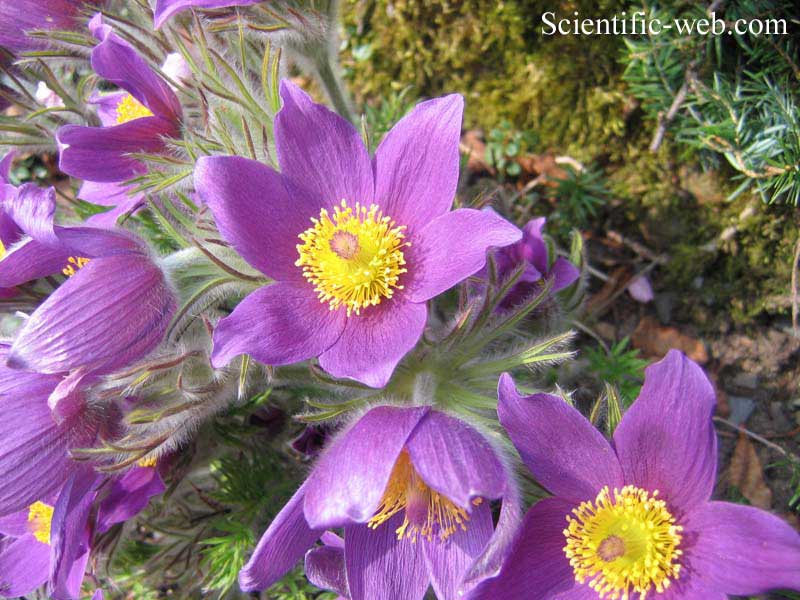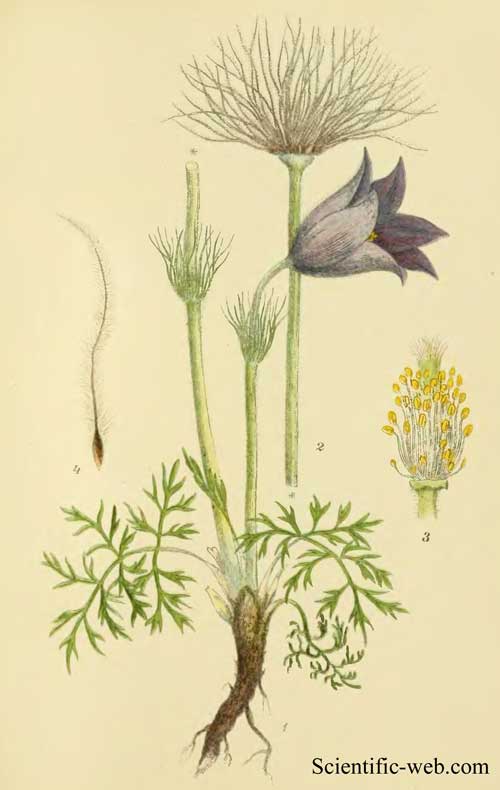
Pulsatilla vulgaris, Photo: Michael Lahanas
Classification System: APG IV
Superregnum: Eukaryota
Regnum: Plantae
Cladus: Angiosperms
Cladus: Eudicots
Ordo: Ranunculales
Familia: Ranunculaceae
Subfamilia: Ranunculoideae
Tribus: Anemoneae
Genus: Pulsatilla
Species: Pulsatilla vulgaris
Name
Pulsatilla vulgaris Mill., Gard. Dict. ed. 8: n.º 1 (1768).
Synonyms
Replaced synonym
Anemone pulsatilla L., Sp. Pl. 1: 539 (1753).
Heterotypic
Pulsatilla recta Gilib., Fl. Lit. Inch. 2: 278 (1782).
Anemone sylvestris Vill., Hist. Pl. Dauphiné 3: 726 (1789).
Anemone pratensis Sibth., Fl. Oxon.: 169 (1794).
Anemone collina Salisb., Prodr. Stirp. Chap. Allerton: 371 (1796).
Anemone intermedia Schult., Observ. Bot.: 101 (1809).
Anemone acutipetala Schleich., Cat. Pl. Helv., ed. 3: 6 (1815).
Anemone tenuifolia Schleich., Cat. Pl. Helv., ed. 4: 7 (1821).
Pulsatilla intermedia Sweet, Hort. Brit., ed. 2: 3 (1830).
Pulsatilla bogenhardiana Rchb., Icon. Fl. Germ. Helv. 4: 18 (1840).
Pulsatilla media Bogenh., Flora 23: 74 (1840).
Anemone bogenhardiana (Rchb.) Pritz., Linnaea 15: 591 (1842).
Pulsatilla amoena Jord., Ann. Soc. Linn. Lyon, n.s., 7: 422 (1861).
Pulsatilla propera Jord., Ann. Soc. Linn. Lyon, n.s., 7: 422 (1861).
Pulsatilla aperta Schur, Enum. Pl. Transsilv.: 4 (1866).
Pulsatilla transsilvanica Schur, Enum. Pl. Transsilv.: 5 (1866).
Pulsatilla oenipontana Dalla Torre & Sarnth., Fl. Tirol 6(2): 248 (1909).
Pulsatilla vulgaris var. anglica W.Zimm., Feddes Repert. 70: 145 (1965).
Anemone pulsatilla f. henryi (Christ) Tosco, Webbia 31: 149 (1977).
Pulsatilla vulgaris subsp. anglica (W.Zimm.) P.D.Sell, Fl. Gr. Brit. Ireland 1: 671 (2018).

References
Primary references
Linnaeus, C. 1753. Species Plantarum. Tomus I: 539. Reference page.
Miller, P. 1768. Gard. Dict. ed. 8: Pulsatilla #1.
Additional references
Hoot, S.B., Meyer, K.M. & Manning, J.C. 2012. Phylogeny and Reclassification of Anemone (Ranunculaceae), with an Emphasis on Austral Species. Systematic Botany 37(1): 139–152 (150!). DOI: 10.1600/036364412X616729 PDF Reference page.
Links
Hassler, M. 2021. Pulsatilla vulgaris. World Plants: Synonymic Checklists of the Vascular Plants of the World In: Roskovh, Y., Abucay, L., Orrell, T., Nicolson, D., Bailly, N., Kirk, P., Bourgoin, T., DeWalt, R.E., Decock, W., De Wever, A., Nieukerken, E. van, Zarucchi, J. & Penev, L., eds. 2021. Species 2000 & ITIS Catalogue of Life. Published online. Accessed: 2021 April 28. Reference page.
Govaerts, R. et al. 2021. Pulsatilla vulgaris in Kew Science Plants of the World online. The Board of Trustees of the Royal Botanic Gardens, Kew. Published online. Accessed: 2021 April 28. Reference page.
International Plant Names Index. 2021. Pulsatilla vulgaris. Published online. Accessed: 28 April 2021.
Vernacular names
azərbaycanca: Yuxu güləbətini
башҡортса: Йоҡо үләне
català: Flor de pasqua
kaszëbsczi: Zwëczajnô grużdżelnica
čeština: koniklec německý
Cymraeg: Blodyn y Pasg
dansk: Opret Kobjælde
Deutsch: Gewöhnliche Kuhschelle
dolnoserbski: Lěkarska bimbawka
English: Pasqueflower
Esperanto: Ordinara pulsatilo
español: Pulsatilla común
suomi: Ketokylmänkukka, lännenkylmänkukka
français: Anémone pulsatille
hornjoserbsce: Lěkarska bimbawka
magyar: nyugati kökörcsin
日本語: セイヨウオキナグサ
Lëtzebuergesch: Däiwelsbaart
lietuvių: Paprastoji šilagėlė
Nederlands: Wildemanskruid
polski: sasanka zwyczajna
русский: Прострел обыкновенный
slovenčina: poniklec obyčajný
svenska: Backsippa
Tiếng Việt: Bạch đầu ông
Pulsatilla vulgaris, the pasqueflower,[3] is a species of flowering plant belonging to the buttercup family (Ranunculaceae), found locally on calcareous grassland in Europe,[4] and widely cultivated in gardens. It was considered part of the genus Anemone, to which it is closely related.[5] Several sources still list Anemone pulsatilla as the accepted name, with Pulsatilla vulgaris as a synonym.[6]
Other variations of its common name include European pasqueflower and common pasqueflower. The name may also be split in two - pasque flower.
Description
This herbaceous perennial plant develops upright rhizomes, which function as food-storage organs. Its leaves and stems are long, soft, silver-grey and hairy. It grows to 15–30 cm (6–12 in) high and when it is fruit-bearing up to 40 cm (16 in). The roots go 1 m (39 in) deep into the soil. The finely-dissected leaves are arranged in a rosette and appear with the bell-shaped flower in early spring. The purple flowers are followed by distinctive silky seed-heads which can persist on the plant for many months.
The flower is 'cloaked in myth'; one legend has it that Pasque flowers sprang up in places that had been soaked by the blood of Romans or Danes because they often appear on old barrows and boundary banks.[7]
This plant has gained the Royal Horticultural Society's Award of Garden Merit.[3][8]
Designation
It is classified as a Priority Species in the UK Biodiversity Action Plan[9] and as Vulnerable in Britain on the Red Data List.[7]
Location
It grows in sparsely wooded pine forests or meadows, often on a sunny sloping side with calcium-rich soil. A large colony occurs on publicly accessible land in the Cotswolds, UK, at the Gloucestershire Wildlife Trust's Pasqueflower reserve.[10]
Additional general information
It is the county flower of the English counties of Cambridgeshire and Hertfordshire.[11]
Varieties
While the species Pulsatilla vulgaris has purplish flowers; variants include red ('Rubra') and white ('Alba') forms (see images).
References
Schweizer, F.; Hasinger, O. (2014). "Pulsatilla vulgaris". IUCN Red List of Threatened Species. 2014: e.T161913A50786112. doi:10.2305/IUCN.UK.2014-1.RLTS.T161913A50786112.en. Retrieved 18 November 2021.
"Pulsatilla vulgaris Mill. | Plants of the World Online | Kew Science". Plants of the World Online.
"RHS Plant Selector - Pulsatilla vulgaris". Retrieved 23 February 2020.
Shorter Oxford English Dictionary, 6th edition. United Kingdom: Oxford University Press. 2007. p. 3804. ISBN 978-0199206872.
RHS encyclopedia of plants & flowers. United Kingdom: Dorling Kindersley. 2010. p. 744. ISBN 978-1405354233.
"Pulsatilla vulgaris". World Flora Online. Retrieved 24 March 2021.
"Species detail on the Wildlife Trusts' website". Archived from the original on 2013-05-19. Retrieved 2012-04-11.
"AGM Plants - Ornamental" (PDF). Royal Horticultural Society. July 2017. p. 82. Retrieved 23 September 2018.
Joint Nature Conservation Committee - UK Biodiversity Action Plan. The Committee operates in a statutory advisory capacity to the UK Government.
"Pasqueflower reserve information on the Gloucestershire Wildlife Trust website".
"Pasqueflower | Plant & fungi species | Wild plants". www.plantlife.org.uk. Retrieved 2016-01-03.
Retrieved from "http://en.wikipedia.org/"
All text is available under the terms of the GNU Free Documentation License

